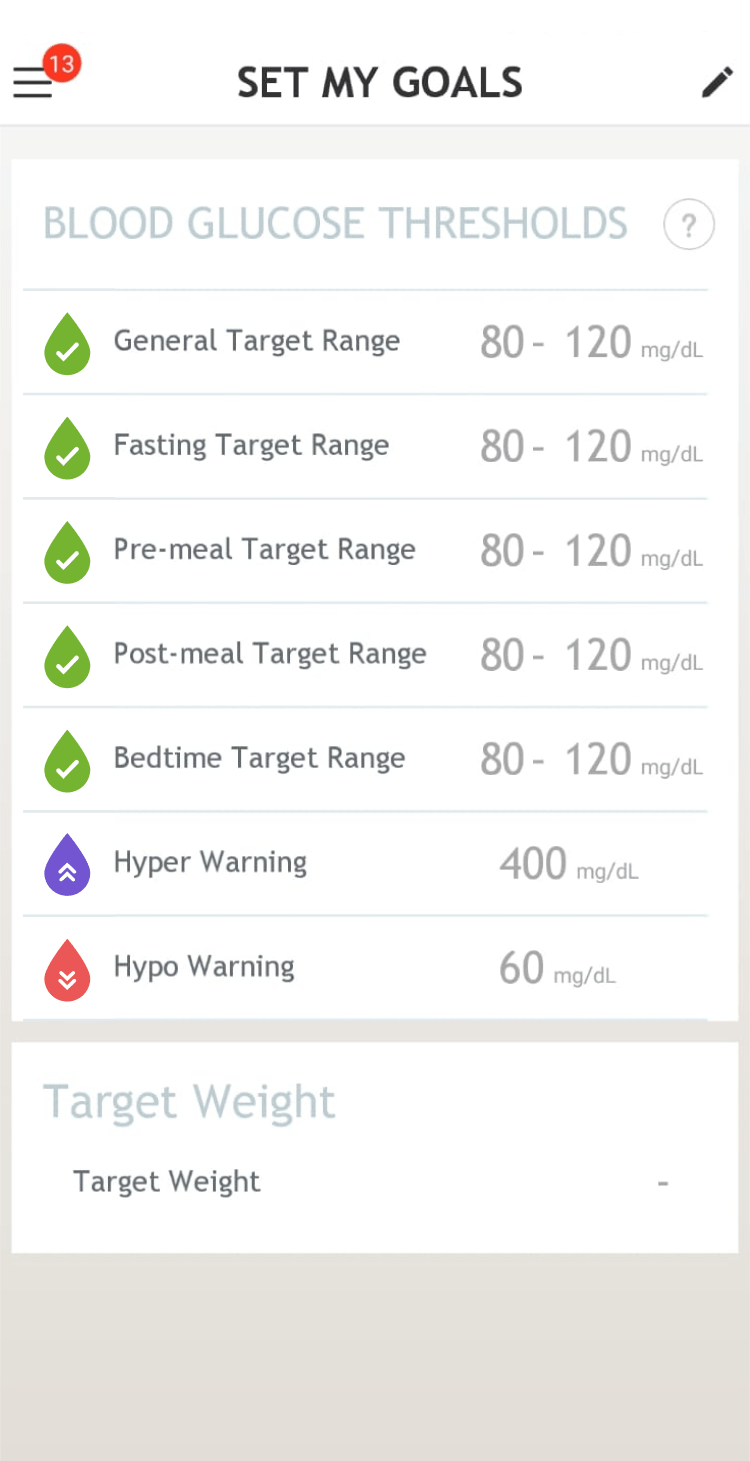There are several different ways your doctor can diagnose diabetes. In this article, we present the tests used to diagnose prediabetes and diabetes and explain the significance of each test.
Along with your diagnosis, your doctor will recommend your target values for subsequent fasting tests, testing after meals, and your HbA1c goal.
Below are ADA diagnostic criteria for type 2 diabetes: 1
| Normal Blood Glucose | Prediabetes | Diabetes |
|---|---|---|
| Fasting Plasma Glucose (FPG) ≤100 mg/dL (5.5 mmol/L)
Oral Glucose Tolerance Test (OGTT) – 2-hour Plasma Glucose <140 mg/dL (<7.8 mmol/L) |
Fasting Plasma Glucose (FPG) 100 mg/dl (5.5 mmol/L) to 125 mg/dL (6.9 mmol/L) =IFG
75-g Oral Glucose Tolerance Test (OGTT) _ 2-hour Plasma Glucose 140 mg/dL (7.8 mmol/L) to 199 mg/dl (11.05 mmol/L) = Impaired Glucose Tolerance (IGT) Glycated hemoglobin (A1c) 5.7-6.4% |
Fasting Plasma Glucose (FPG) ≥126 (≥7.0 mmol/L)
or or or |
Note that all diagnostic tests are conducted through a laboratory blood test and not with self-monitored tests with a glucometer.
Fasting plasma glucose/impaired fasting glucose
This test indicates the quantity of glucose in your blood after an overnight fast. Fasting blood glucose tests for people with type 2 diabetes show how well your body’s insulin responds to periods without food, such as overnight. For those with type 1 diabetes, fasting blood glucose levels show whether your long-term insulin, also known as background insulin, is set at the right dose. A blood sample is taken after fasting for at least eight hours. Diabetes is typically diagnosed when fasting blood glucose levels are 126 mg/dl (7.0 mmol/L) or higher.
Oral glucose tolerance test
A glucose tolerance test measures how well your body’s cells are able to absorb glucose (sugar) after you consume a specific amount of sugar. For this test, you fast overnight and a fasting blood sample is taken. You then drink a sugary liquid which contains 75 grams of glucose. Your blood sugar levels are tested several times within the next two hours. A blood glucose level between 140 and 199 mg/dL (7.8 and 11.05 mmol/L) is considered impaired glucose tolerance, or prediabetes. A blood glucose level of 200 mg/dL (11.1 mmol/L) or higher may indicate diabetes.
HbA1c
This blood test doesn’t require fasting. It indicates your average blood sugar level for the past two to three months. It measures the percentage of blood sugar attached to hemoglobin, the oxygen-carrying protein in red blood cells.
The higher your blood sugar levels, the more hemoglobin you’ll have with sugar attached. An A1c level of 6.5 percent or higher on two separate tests indicates that you have diabetes. An A1c between 5.7 and 6.4 percent indicates prediabetes. An A1c level below 5.7 is considered normal. The test can be done at any time because it is not affected by short-term changes in sugar values, such as meals, exercise, stress, etc.
In this table you can see the average glucose (eAG) in relation to both fasting sugar levels and sugar levels two hours after meals for three months. The HbA1c (%) column shows the corresponding A1c result.
For example: if your average glucose for the day during monitoring with Dario is 123-185mg/dL (6.8-10.3 mmol/L), you can estimate that your A1c is 7%.
This is a good option to help you maintain your A1c goal and improve your glucose values for three months until the next A1c test.
| HbA1c (%) | eAG ( estimated average glucose) ( mmol/L ) | eAG ( estimated average glucose ) ( mg/dL ) |
| 5
6 7 8 9 10 11 12 13 14 15 16 17 18 19 |
5.4 (4.2–6.7)
7.0 (5.5–8.5) 8.6 (6.8–10.3) 10.2 (8.1–12.1) 11.8 (9.4–13.9) 13.4 (10.7–15.7) 14.9 (12.0–17.5) 16.5 (13.3–19.3) 18.1 (15–21) 19.7 (16–23) 21.3 (17–25) 22.9 (19–26) 24.1 (20–28) 26.1 (21-30) 27.7 (23-32) |
97 (76–120)
126 (100–152) 154 (123–185) 183 (147–217) 212 (170–249) 240 (193–282) 269 (217–314) 298 (240–347) 326 (260–380) 355 (290–410) 384 (310–440) 413 (330–480) 441 (460–510) 470 (380–540 499 (410-570) |
Dario’s App allows you to easily tag your goals on the “SET MY GOALS” page.

Remember to log your fasting glucose and test your sugar periodically after meals and before bed as recommended by your health care team.
It is important to tag and track sugar levels. The more you check at different times throughout the day, the better you will be at reaching your goals.
- Diabetes Care, American Diabetes Association, 2020
- “Complete nurse’s guide to Diabetes care” Belinda P. Childs et al American Diabetes Association 2017.
Units of measurement, which are shown in some of the photos and videos, represent US standard units
DAR-0165 RevB